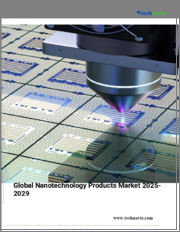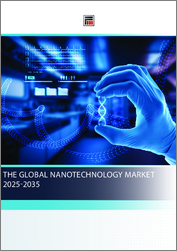
|
시장보고서
상품코드
1698416
세계의 나노툴 시장 : 예측(2025-2030년)Nanotools Market - Forecasts from 2025 to 2030 |
||||||
나노툴 시장은 예측 기간 동안 8.99%의 연평균 복합 성장률(CAGR)로 성장하여 2025년 시장 규모 204억 7,571만 4,000달러에서 2030년에는 314억 8,285만 7,000달러에 달할 것으로 예측됩니다.
나노툴 시장은 나노 스케일에서 재료의 제조, 측정, 조작에 사용되는 기기, 장치, 소프트웨어를 의미합니다. 이 시장은 연구, 제조, 다양한 산업 응용 분야에서 나노 기술 기반 도구의 사용을 대상으로 합니다.
시장 동향 :
- 최소침습 수술에 대한 관심 증가
2020년 미국 국립보건원 국립의학도서관(National Library of Medicine)의 복강경 및 로봇수술학회(Society of Laparoscopic and Robotic Surgeons) 저널에 발표된 연구에 따르면, 2003년부터 2019년까지 미국에서 일반외과 레지던트가 수행하는 최소침습수술이 크게 증가했다고 합니다. 사이에 미국에서 일반외과 레지던트들이 시행하는 최소침습수술이 크게 증가했음을 강조하고 있습니다. 이 연구는 담낭 절제술(88%에서 94%로), 살서제 탈장 수술(20%에서 47%로), 맹장 절제술(38%에서 93%로), 대장 절제술(8%에서 43%로), 위 절제술(43%에서 84%로), Nissen 성형술(71%에서 91%로)과 같은 수술 증가를 보고했습니다. 증가했습니다.
- 저침습 성형으로의 전환
미용 산업도 저침습적 기술을 도입하고 있으며, 이는 나노툴 시장을 더욱 촉진할 것으로 예측됩니다. 미국 성형외과학회(American Society of Plastic Surgeons)의 Plastic Surgery Statistics Report에 따르면, 미국 내 보툴리눔 톡신 A형(보톡스, 디스포트, 제오민) 등 저침습적 미용 성형수술의 건수는 2000년 786,911건에서 2020년 4,401,536건으로 급증했습니다. 전체적으로는 2000년 484만 7561건에서 2020년에는 1575만 363건에 달할 것으로 예측됩니다.
- 북미와 아시아태평양이 시장을 독점하다
지리적으로는 북미가 특히 미국의 최소침습 수술에 대한 수요 증가로 인해 큰 시장 점유율을 차지할 것으로 예측됩니다. 이 지역의 첨단 의료 인프라와 나노툴을 포함한 혁신 기술의 높은 채택률이 이 시장의 우위에 기여하고 있습니다. 반면, 아시아태평양은 의료비 지출 증가와 전자 및 반도체 등의 산업에서 나노툴의 사용 확대로 인해 큰 폭의 성장이 예상됩니다.
이 보고서에서 다루는 주요 기업으로는 Heidelberg Instruments, Thermo Fisher Scientific, Bruker Corporation, Oxford Instruments, Carl Zeiss AG, Raith GmbH, Nanonics Imaging Ltd., Applied Nanotools 등이 있습니다.
본 보고서의 주요 장점
- 통찰력 있는 분석 : 고객 부문, 정부 정책 및 사회경제적 요인, 소비자 선호도, 산업별, 기타 하위 부문에 초점을 맞추고 주요 지역뿐만 아니라 신흥 지역까지 포괄하는 상세한 시장 인사이트을 얻을 수 있습니다.
- 경쟁 구도: 세계 주요 기업들이 채택하고 있는 전략적 전략을 이해하고, 적절한 전략을 통한 시장 침투 가능성을 파악할 수 있습니다.
- 시장 동향과 촉진요인 : 역동적인 요인과 매우 중요한 시장 동향, 그리고 이들이 향후 시장 개척을 어떻게 형성할 것인지에 대해 알아봅니다.
- 실행 가능한 제안: 역동적인 환경 속에서 새로운 비즈니스 스트림과 수익을 발굴하기 위한 전략적 의사결정에 통찰력을 활용합니다.
- 스타트업, 연구기관, 컨설턴트, 중소기업, 대기업 등 다양한 사용자에게 유용하고 비용 효율적입니다.
어떤 용도로 사용되는가?
산업 및 시장 인사이트, 사업 기회 평가, 제품 수요 예측, 시장 진출 전략, 지리적 확장, 설비 투자 결정, 규제 프레임워크 및 영향, 신제품 개발, 경쟁의 영향
조사 범위
- 2022년부터 2024년까지의 과거 데이터 & 2025년부터 2030년까지의 예측 데이터
- 성장 기회, 과제, 공급망 전망, 규제 프레임워크 및 동향 분석
- 경쟁사 포지셔닝, 전략 및 시장 점유율 분석
- 매출 성장 및 예측 분석(국가 및 지역을 포함한 부문 및 지역)
- 기업 프로파일링(전략, 제품, 재무정보, 주요 동향 등)
목차
제1장 서론
- 시장 개요
- 시장의 정의
- 조사 범위
- 시장 세분화
- 통화
- 전제조건
- 기준연도과 예측연도 타임라인
- 이해관계자에게 있어서의 주요 이점
제2장 조사 방법
- 조사 디자인
- 조사 과정
제3장 주요 요약
- 주요 조사 결과
제4장 시장 역학
- 시장 성장 촉진요인
- 시장 성장 억제요인
- Porter의 Five Forces 분석
- 업계 밸류체인 분석
- 애널리스트의 견해
제5장 나노툴 시장 : 제품 유형별
- 서론
- 나노리소그래피
- 현미경
- 나노매니퓰레이터
- 나노 가공 툴
- 기타
제6장 나노툴 시장 : 용도별
- 서론
- 일렉트로닉스 및 반도체
- 헬스케어 및 생명과학
- 재료 과학 및 에너지
- 항공우주 및 방위
- 기타
제7장 나노툴 시장 : 최종사용자 업계별
- 서론
- 일렉트로닉스 및 반도체
- 재생에너지
- 광업
- 야금
- 헬스케어
- 바이오테크놀러지
- 기타
제8장 나노툴 시장 : 지역별
- 서론
- 아메리카
- 제품 유형별
- 용도별
- 최종사용자 업계별
- 국가별
- 유럽, 중동 및 아프리카
- 제품 유형별
- 용도별
- 최종사용자 업계별
- 국가별
- 아시아태평양
- 제품 유형별
- 용도별
- 최종사용자 업계별
- 국가별
제9장 경쟁 환경과 분석
- 주요 기업과 전략 분석
- 시장 점유율 분석
- 합병, 인수, 합의 및 협업
- 경쟁 대시보드
제10장 기업 개요
- Heidelberg Instruments
- Thermo Fisher Scientific
- Bruker Corporation
- Oxford Instruments
- Carl Zeiss AG
- Raith GmbH
- Nanonics Imaging Ltd.
- Applied Nanotools
- Nanophase Technologies Corporation
- NIL Technology
- Hitachi High Technology Corporation(SII NanoTechnology Inc.)
제11장 부록
- 통화
- 전제조건
- 기준연도과 예측연도 타임라인
- 이해관계자에게 있어서의 주요 이점
- 조사 방법
- 약어
The Nanotools market is expected to grow at a CAGR of 8.99% over the forecast period, reaching a market size of US$31,482.857 million in 2030 from US$20,475.714 million in 2025.
The nanotools market refers to the instruments, devices, and software used for fabricating, measuring, and manipulating materials at the nanoscale. The market covers the use of nanotechnology-based tools in research, manufacturing, and various industrial applications.
Market Trends:
- Increasing preference for minimally invasive surgeries
The rising demand for minimally invasive surgeries is driving the growth of the nanotools market, as these tools are integral to such procedures. A study published in the Journal of the Society of Laparoscopic and Robotic Surgeons (US NLM, NIH) in 2020 highlighted a significant increase in minimally invasive surgeries performed by general surgery residents in the U.S. between 2003 and 2019. The study reported growth in procedures such as cholecystectomy (from 88% to 94%), inguinal hernia repair (from 20% to 47%), appendectomy (from 38% to 93%), colectomy (from 8% to 43%), gastrectomy (from 43% to 84%), and Nissen fundoplication (from 71% to 91%).
- Shift towards minimally invasive cosmetic procedures
The cosmetic industry is also embracing minimally invasive techniques, which is expected to further boost the nanotools market. According to the Plastic Surgery Statistics Report by the American Society of Plastic Surgeons, the number of minimally invasive cosmetic procedures in the U.S., such as Botulinum Toxin Type A (Botox, Dysport, Xeomin), surged from 786,911 in 2000 to 4,401,536 in 2020. Overall, minimally invasive cosmetic procedures reached 15,750,363 in 2020, up from 4,847,561 in 2000.
- North America and Asia Pacific to dominate the market
Geographically, North America is expected to hold a significant market share due to the growing demand for minimally invasive surgeries, particularly in the United States. The region's advanced healthcare infrastructure and high adoption rates of innovative technologies, including nanotools, contribute to its market dominance. Meanwhile, the Asia Pacific region is poised for substantial growth, driven by increased healthcare spending and the expanding use of nanotools in industries such as electronics and semiconductors.
Some of the major players covered in this report include Heidelberg Instruments, Thermo Fisher Scientific, Bruker Corporation, Oxford Instruments, Carl Zeiss AG, Raith GmbH, Nanonics Imaging Ltd., Applied Nanotools, among others.
Key Benefits of this Report:
- Insightful Analysis: Gain detailed market insights covering major as well as emerging geographical regions, focusing on customer segments, government policies and socio-economic factors, consumer preferences, industry verticals, and other sub-segments.
- Competitive Landscape: Understand the strategic maneuvers employed by key players globally to understand possible market penetration with the correct strategy.
- Market Drivers & Future Trends: Explore the dynamic factors and pivotal market trends and how they will shape future market developments.
- Actionable Recommendations: Utilize the insights to exercise strategic decisions to uncover new business streams and revenues in a dynamic environment.
- Caters to a Wide Audience: Beneficial and cost-effective for startups, research institutions, consultants, SMEs, and large enterprises.
What do businesses use our reports for?
Industry and Market Insights, Opportunity Assessment, Product Demand Forecasting, Market Entry Strategy, Geographical Expansion, Capital Investment Decisions, Regulatory Framework & Implications, New Product Development, Competitive Intelligence
Report Coverage:
- Historical data from 2022 to 2024 & forecast data from 2025 to 2030
- Growth Opportunities, Challenges, Supply Chain Outlook, Regulatory Framework, and Trend Analysis
- Competitive Positioning, Strategies, and Market Share Analysis
- Revenue Growth and Forecast Assessment of segments and regions including countries
- Company Profiling (Strategies, Products, Financial Information, and Key Developments among others)
Nanotools Market is analyzed into the following segments:
By Product Type
- Nanolithography
- Microscopes
- Nano-Manipulators
- Nano Machining Tools
- Others
By Application
- Electronics & semiconductors
- Healthcare & Life Sciences
- Material Science and Energy
- Aerospace and Defense
- Others
By End-User Industry
- Electronics and Semiconductor
- Renewable Energy
- Mining
- Metallurgy
- Healthcare
- Biotechnology
- Others
By Region
- Americas
- US
- Europe, Middle East, and Africa
- Germany
- Netherlands
- Others
- Asia Pacific
- China
- Japan
- Taiwan
- South Korea
- Others
TABLE OF CONTENTS
1. INTRODUCTION
- 1.1. Market Overview
- 1.2. Market Definition
- 1.3. Scope of the Study
- 1.4. Market Segmentation
- 1.5. Currency
- 1.6. Assumptions
- 1.7. Base and Forecast Years Timeline
- 1.8. Key benefits for the stakeholders
2. RESEARCH METHODOLOGY
- 2.1. Research Design
- 2.2. Research Process
3. EXECUTIVE SUMMARY
- 3.1. Key Findings
4. MARKET DYNAMICS
- 4.1. Market Drivers
- 4.2. Market Restraints
- 4.3. Porter's Five Forces Analysis
- 4.3.1. Bargaining Power of Suppliers
- 4.3.2. Bargaining Power of Buyers
- 4.3.3. Threat of New Entrants
- 4.3.4. Threat of Substitutes
- 4.3.5. Competitive Rivalry in the Industry
- 4.4. Industry Value Chain Analysis
- 4.5. Analyst View
5. NANOTOOLS MARKET BY PRODUCT TYPE
- 5.1. Introduction
- 5.2. Nanolithography
- 5.3. Microscopes
- 5.4. Nano-Manipulators
- 5.5. Nano Machining Tools
- 5.6. Others
6. NANOTOOLS MARKET BY APPLICATION
- 6.1. Introduction
- 6.2. Electronics & semiconductors
- 6.3. Healthcare & Life Sciences
- 6.4. Material Science and Energy
- 6.5. Aerospace and Defense
- 6.6. Others
7. NANOTOOLS MARKET BY END-USER INDUSTRY
- 7.1. Introduction
- 7.2. Electronics and Semiconductor
- 7.3. Renewable Energy
- 7.4. Mining
- 7.5. Metallurgy
- 7.6. Healthcare
- 7.7. Biotechnology
- 7.8. Others
8. NANOTOOLS MARKET BY GEOGRAPHY
- 8.1. Introduction
- 8.2. Americas
- 8.2.1. By Product Type
- 8.2.2. By Application
- 8.2.3. By End-User Industry
- 8.2.4. By Country
- 8.2.4.1. US
- 8.3. Europe, Middle East & Africa
- 8.3.1. By Product Type
- 8.3.2. By Application
- 8.3.3. By End-User Industry
- 8.3.4. By Country
- 8.3.4.1. Germany
- 8.3.4.2. Netherlands
- 8.3.4.3. Others
- 8.4. Asia Pacific
- 8.4.1. By Product Type
- 8.4.2. By Application
- 8.4.3. By End-User Industry
- 8.4.4. By Country
- 8.4.4.1. China
- 8.4.4.2. Japan
- 8.4.4.3. Taiwan
- 8.4.4.4. South Korea
- 8.4.4.5. Others
9. COMPETITIVE ENVIRONMENT AND ANALYSIS
- 9.1. Major Players and Strategy Analysis
- 9.2. Market Share Analysis
- 9.3. Mergers, Acquisitions, Agreements, and Collaborations
- 9.4. Competitive Dashboard
10. COMPANY PROFILES
- 10.1. Heidelberg Instruments
- 10.2. Thermo Fisher Scientific
- 10.3. Bruker Corporation
- 10.4. Oxford Instruments
- 10.5. Carl Zeiss AG
- 10.6. Raith GmbH
- 10.7. Nanonics Imaging Ltd.
- 10.8. Applied Nanotools
- 10.9. Nanophase Technologies Corporation
- 10.10. NIL Technology
- 10.11. Hitachi High Technology Corporation (SII NanoTechnology Inc.)
11. APPENDIX
- 11.1. Currency
- 11.2. Assumptions
- 11.3. Base and Forecast Years Timeline
- 11.4. Key benefits for the stakeholders
- 11.5. Research Methodology
- 11.6. Abbreviations



















